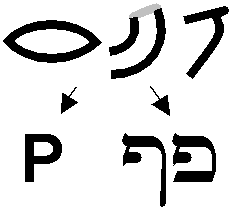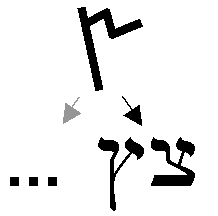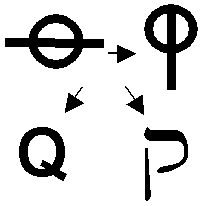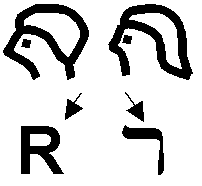The Script that went Ahead
How YaHUaH prepared the way for the Gospel in Greece and Rome
already at the time when Isra’el diverted from Him
Part III.
André H. Roosma
11 August 2015
In Part I of this article, I told the story of our (Latin) script; how its origin can be found in the old West-Semitic
(a.k.a. Canaanite or Sinaitic) script Moses used
when he wrote the Torah.1 I expressed my awe and wonder about the
observation that God had the Greeks and then the Romans adopt it, with some
minor modifications, at the time when the northern Israelites and the Jews
went into exile, respectively. And that this script and the far-stretching
Roman empire greatly facilitated the spread of the written Gospel and the
other New Testament as well as First Testament writings...
Here a sequel to Part II of the discussion of the various letters from the aleph-bet
as Moses used it and how they were adopted into the Greek and Latin
worlds. And then I will finish this three-part article with some concluding
remarks.
The development of the letter signs (continued)
The letters of the old script of Isra’el (top
row in each picture) were at the basis of our (Latin) letters (bottom, left), and of the
Imperial Aramaic of the sixth to fifth century BC, from which the Hebrew
square script letters (bottom right) were
adopted.

The next symbol of the old Semitic script from the time of the
Patriarchs and Mosheh (top, left and middle show two
variants) was a picture of an opening between two pieces of tent
canvas. The symbol represented any opening and the notion of airflow (note that the primary opening of the human body - the
’aph - is not the mouth but the nose; de mouth - peh -
is literally the opening to express awe, worship and joy).
In early Paleo-Hebrew (top, right) this symbol
got changed a bit by the way it was written by hand as one stroke. The
Greeks simplified and straightened an older form a little to form their
pi Π; the Romans changed the shape
considerably to P.
The Aramaeans changed the symbol somewhat and created a separate final
version. This looks much like the Latin P (mirrored, of course), but which way this influence went is hard to
establish.

The tsade of the old Semitic script was a depiction of a plant
like grain, reed or papyrus. Via the way these plants grow (straight up, without bents or dividing into branches),
it also symbolized being or growing upright. Via the papyrus it also
symbolized pressing or squeezing out water.
In early Paleo-Hebrew this symbol changed little. It inspired the Greeks
at first in their Ϡ or ϡ - sampi, which was later
discarded, however. The Romans did not adopt it.
In Aramaic and the Hebrew square script, the symbol got changed such that
the image of straight-up growth with a single stem got lost.

The next symbol of the old Semitic script is the qoph, depicting a
rising sun, representing notions as: to rise, to revolve, light. In the
course of time it just got turned 90 degrees.
The Greeks adopted it rather straightforwardly in their Ϙ, calling it qoppa, but
discarded it later. The Romans adopted it as the letter Q.
In Aramaic, the letter shape changed little and remained almost as
recognizable as our Latin Q (mirrored).

The next symbol of the old Semitic script depicted a man’s head;
all kinds of local versions are known varying to local custom. It
signified a head person, i.e. any high official or God. In Paleo-Hebrew it
got simplified considerably to a triangle with a leg on the right side;
beyond recognition, that is.
The Greeks adopted this later variant while rounding off the triangle:
Ρ, calling it rho. The Romans copied
this but added an extra line to differentiate it from the P: R.
In Aramaic, the letter shape got further simplified from the Paleo-Hebrew
(compare our small r, mirrored!).

One of the most mysterious letters in the old Semitic script was the
shin or shad. It is not known yet for certain what its
various representations depicted. Possibly, it is a later confluence of
two symbols, one of which represented motherly breasts, another perhaps a
pair of bull’s horns. Often, it signifies any well and the notion of
bulging or having something come forth.
The Greeks adopted one of the original symbols rather straightforwardly,
as the Σ, calling it sigma. The
Romans altered the orientation of the lower half to create the S.
In Aramaic the letter shape got changed a little. Somewhere in history,
it became used for the sin as well.

The old letter tav depicted a wooden cross. It symbolized the
completion of anything, any complex construction, and also an underwriting.
In Paleo-Hebrew it got turned 45 degrees to make it easier to write.
The Greeks adopted the original letter as their tau: Τ, from which the Latin T emerged quite
naturally.
In Aramaic, the letter shape got changed beyond recognition. This is a
great pity as the Jews had probably recognized the cross of Yeshu‘ah earlier when they had kept the old
script, as I showed in the article ‘His
Name is Jesus / Yeshu‘ah’.
In full agreement with its meaning, the tav originally was the last
letter of the West-Semitic ’aleph-bet. That it is no longer so
in the Latin alphabet was only because the Romans added some letters only
later (the U, V, W and Y as second derivatives, next to
the F, from the wav, the X because the S had taken its place, and the
Z from the zayin as it was added only later because it was deemed
unnecessary at first, something even Shakespeare still agreed with:
“Thou whoreson zed! thou unnecessary letter!” from: King
Lear).
As we see, often our Latin letters resemble the old Semitic characters
often better than the Hebrew square script letters derived from Imperial
Aramaic of the sixth to fifth century BC. A similar statement can be made
for the brother of the Latin script, the Cyrillic script as used a.o. in
Russia.
Concluding notes
In this three-part article I have illustrated how the Roman world adopted
the Latin script from the script of the Biblical patriarchs that Moses once
used to write the Torah, the first five books of the Bible. This Latin script
(with its twin brother, the Cyrillic script) became
the script that was instrumental in the world-wide spread of the glorious
Gospel of Yeshu‘ah, the Anointed One, in the
last 20 centuries.
All of the research behind it is based on the Bible and some facts we know
from archeology and sound historical records.
In the great context of God’s ways throughout world history, I find it
truly awesome and amazing how He brought the script I believe He may well
have given to Abraham,2 to the Western world (entire Europe, including Russia), such that roughly three quarters
of a millennium later the Gospel of Yeshu‘ah, the Anointed One, could be spread much easier. The observation
that the spread of the script took place particularly in periods when the
people of Isra’el left YaHUaH, their God, makes it all the more
remarkable. I do see a connection here with those words of the apostle Paul
(Romans 11:7-11):
“What then? Israel failed to obtain
what it sought. The elect obtained it, but the rest were hardened, as
it is written, “God gave them a spirit of stupor, eyes that should
not see and ears that should not hear, down to this very day.” And
David says, “Let their table become a snare and a trap, a pitfall and
a retribution for them; let their eyes be darkened so that they cannot see,
and bend their backs for ever.” So I ask, have they stumbled so as
to fall? By no means! But through their trespass salvation has come to
the Gentiles, so as to make Israel jealous.”
At the time when real Life and Shalom seeped away from Yeru-shalem (note how Yeshu‘ah wept over
this city, that had become renowned for killing God’s prophets - Luke
19:41-44; cf. also Rev.11:8 for the nicknames God uses to describe the
present Jerusalem), God was already preparing a new part of humanity,
new people to carry His message of Love, Grace and of true Life further
– on to the entire world.
And it didn’t stop two millenia ago! Even in the last few centuries,
there were quite some countries and peoples whose languages had never been
put to script, where missionaries from the West were the very first to study
the language and encode it in this script with such a remarkable background.
They did this, to teach the amazing Gospel to these people and to give them
the opportunity to read and study the Bible for themselves...
As noted in the introduction, the people of Isra’el already were
called to be a priesthood to the nations and make YaHUaH known all
over the world, but after Solomon, they generally refused to do so. The
apostle Paul noted that in the first century, often the Jews even hindered
the preaching of the Gospel to other people (1
Thes.2:14-16; cf. Acts 17:13; 13:50; 14:19; 17:5; 18:12; 21:27-31).
Compare also the parables Yeshu‘ah told
about the rebelling servants and the servant who hid the treasure entrusted
to him, and their later fate (Luke 19:11-27;
Mat.21:32-45 - note that the chief priests and the Pharisees - the founding
fathers of modern rabbinic Judaism - recognized He was talking about them
here; and Mat.25:14-31).
When we study the timeline of
Christian missions over the past 20 centuries in detail, we see that
there were periods of acceleration and periods when the spread of the
Gospel did not go so fast. But during all the ages, there was progress.
The community of followers of Yeshu‘ah
never got silenced. And everywhere the Gospel went, a script that descended
from the script of the Biblical Patriarchs, went with it,3 and enabled
the written communication and spreading of that great Gospel message of God
YaHUaH and His amazing Grace and Love, and the Life He wants to give
us. Let us give Him the honor and glory He deserves for His mighty ways
throughout world history!
Hallelu YaH !
Notes
| 1 |
For more about this script, see:
André H. Roosma, ‘The Written
Language of Abraham, Moses and David – A study of the pictographic
roots and basic notions in the underlying fabric of the earliest Biblical
script’  , Hallelu-YaH Draft Research
Report, 1st English version: 18 April 2011 (1st Dutch original: January
2011). , Hallelu-YaH Draft Research
Report, 1st English version: 18 April 2011 (1st Dutch original: January
2011). |
| 2 |
All the earliest finds of this script have been found
in places that Abraham has visited (from the north of Syria to Egypt); all
later traces are found in places where the descendants of Isra’el were
at that particular time (Egypt around 1800-1600 BC, Israel 1500-1100; and
after that the descendant Paleo-Hebrew script, with closely related sister
scripts in particular in areas under strong influence of Isra’el at the
time of David). |
| 3 |
The Encyclopedia of Christian Education (George Thomas Kurian, Mark
Lamport, Eds.; Vol.3, p. 380) notes: “The missionary activity of the
early Middle Ages especially emphasized literacy, if for no other reason than
that literacy promoted reading the Bible. In some cases, whole alphabets or
writing systems were devised by Christian missionaries, deeply influencing
language and literacy patterns still visible today in the linguistic framework
of Europe.” It continues with an exposé about Latin as a prime
language of the church for many centuries.
Omniglot, the online encyclopedia of writing systems & languages
notes about Xhosa, one of the official languages of South Africa and a member of the
Bantu/Nguni family of languages: “A system for writing Xhosa using the
Latin alphabet was devised by Christian missionaries during the early 19th
century.”
In Biblical Translations of Early Missionaries in East and
Central Africa. I. Translations into Swahili, (Asian and African
Studies, 15, 2006, 1, p.80-89), the author, Viera Pawliková-Vilhanová,
states: “In the process of the formation and development of African
literatures in the Latin script started by the activities of the
Christian missions, Swahili literature as well as some other literatures
in African languages with long written traditions, such as Hausa or Fula
occupy a specific place. In virtually all regions of sub-Saharan Africa
outside the reach of Islam, Africans were introduced to written literature
through Christian propaganda, the very first books in their own African
language were produced to advance the Christian cause.”
Even Great Britain was introduced to the Latin script via Christian
missionaries. As the Wikipedia page on the Old
English Latin alphabet says: “Old English was first written in runes
(futhorc) but shifted to a (minuscule) half-uncial script of the Latin
alphabet introduced by Irish Christian missionaries from around the 9th
century.” And even the earlier futhorc runes script had its roots in
Etruscan, and so: in the old script of the Bible! |
|





